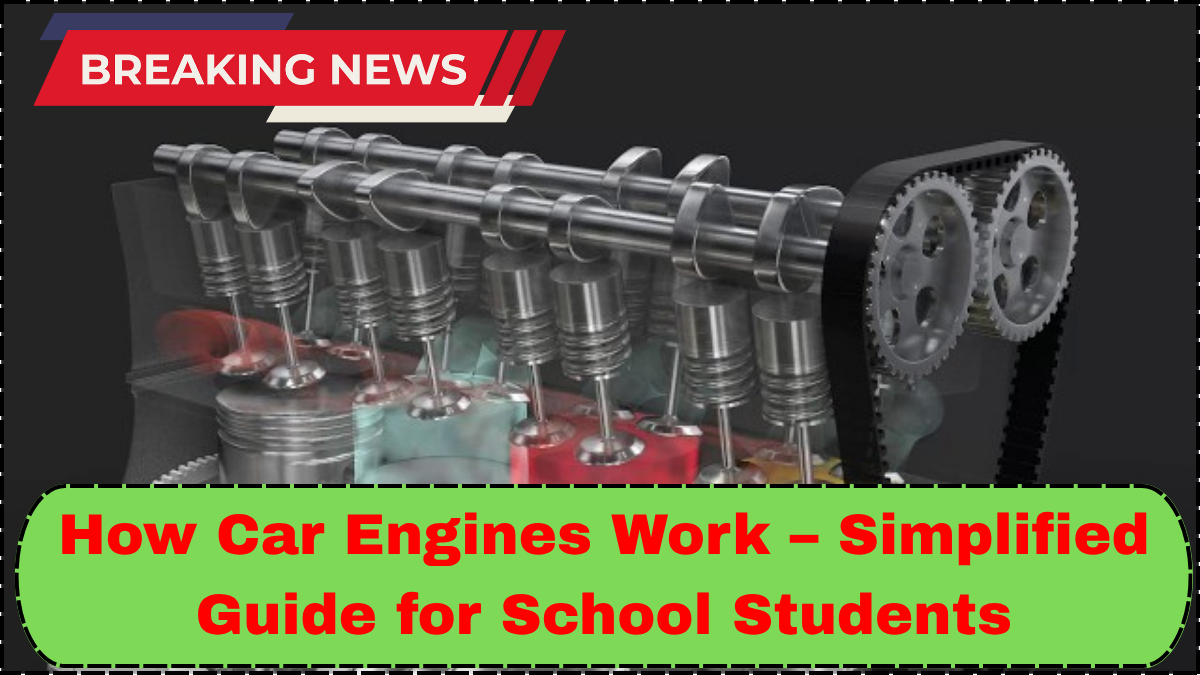Understanding how car engines work might sound complicated, but once broken down, the process is both fascinating and easy to grasp. This guide is tailored for school students who want a clear and simple explanation of how engines work – explained for students in a way that connects science with real-life technology.

What Is a Car Engine?
A car engine is the heart of a vehicle. It’s a machine designed to convert fuel into motion so the car can move. Most engines in traditional cars are internal combustion (IC) engines, while electric cars use electric motors. Despite their differences, both systems serve the same goal—powering the vehicle.
Basic Vehicle Mechanism: The Power Journey
Before diving into engine types, it’s important to understand the basic vehicle mechanism—the chain of events that happen when you press the accelerator:
-
Fuel/Energy enters the engine or motor
-
The engine converts fuel into power (in IC engines) or electricity powers the motor (in EVs)
-
The power turns the crankshaft
-
The crankshaft rotates the wheels through the transmission system
Whether it’s gasoline or electricity, the job of the engine or motor is to provide enough power to turn the wheels.
Internal Combustion Engines (IC Engines)
An internal combustion engine works by burning fuel (like petrol or diesel) inside cylinders. Here’s a simplified breakdown of how it works:
🔧 The Four-Stroke Cycle
Most IC engines use a four-stroke process, repeated hundreds of times per minute:
-
Intake Stroke – Air and fuel enter the cylinder
-
Compression Stroke – The mixture is compressed
-
Power Stroke – A spark plug ignites the mixture, creating an explosion that pushes the piston
-
Exhaust Stroke – Burned gases are expelled
This cycle spins the crankshaft, which moves the wheels through the gearbox.
Example
Think of a balloon. When you fill it with air and let go, the air escapes and pushes the balloon forward. An IC engine works similarly, but much more precisely and powerfully.
Electric Vehicles (EVs): The Modern Alternative
Electric vehicles (EVs) use electric motors instead of combustion engines. These motors are powered by batteries that store electricity.
How EV Engines Work
-
Electricity from the battery goes to the motor
-
The motor generates a magnetic field
-
The magnetic field spins a rotor, creating motion
-
The wheels turn using this rotational energy
EVs don’t need fuel, spark plugs, or exhaust systems. They’re cleaner, quieter, and have fewer moving parts.
IC vs EV – What’s the Difference?
| Feature | Internal Combustion Engine (IC) | Electric Vehicle (EV) |
|---|---|---|
| Power Source | Petrol/Diesel | Electricity |
| Emissions | Produces CO₂ and other gases | Zero tailpipe emissions |
| Maintenance | More frequent (oil changes, spark plugs) | Less frequent (fewer parts) |
| Noise | Noisier | Quieter |
| Efficiency | Lower (lots of energy lost as heat) | Higher (most energy used to drive) |
While IC engines have been around for over a century, EVs are becoming more common due to environmental concerns and advancements in battery technology.
Why Understanding Engines Matters for Students
Knowing how engines work – explained for students helps you see the science behind everyday machines. It combines physics (like motion and energy), chemistry (fuel combustion), and even environmental studies (pollution and sustainability).
Understanding engines can also inspire interest in careers like automotive engineering, robotics, or sustainable energy.
FAQs
Q1: What’s the biggest difference between IC engines and EV motors?
A: IC engines burn fuel inside cylinders, while EV motors use electricity and magnets to create motion.
Q2: Are electric engines easier to maintain?
A: Yes. EVs have fewer moving parts, so they typically require less maintenance than IC engines.
Q3: Can a vehicle have both an IC engine and an electric motor?
A: Yes. These are called hybrid vehicles. They switch between gasoline and electric power for better efficiency.
Q4: Why do IC engines produce pollution?
A: Burning fuel releases carbon dioxide and other gases into the air, which contributes to air pollution and climate change.
Q5: Which type of engine is better for the environment?
A: EV motors are better because they produce zero emissions when driving, especially if powered by renewable electricity.
click here to learn more